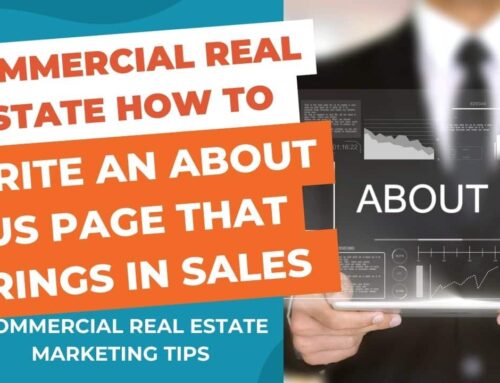Navigating a commercial real estate website shouldn’t feel like finding your way through a maze. Remember that one time you clicked away in frustration?
A seamless, engaging online experience can be the difference between a quick browse and a new client. It’s like walking into a well-organized office – you know you’re in good hands.
Elevating User Experience
Think of your website as your digital storefront for example. It should invite users in with open arms, thanks to an intuitive layout and responsive design. This means fast load times, crisp images, and easy-to-navigate menus that guide visitors effortlessly to the information they’re seeking.
Remember, your site is often the first touchpoint with potential clients. A sophisticated search function and clear, compelling content can help ensure they find exactly what they need with minimal fuss—turning curious clicks into concrete leads.
Intuitive Navigation
Easy-to-use menus guide visitors effortlessly through your commercial real estate offerings.
Efficient navigation increases user retention, ensuring more potential clients view your property portfolios.
Crafting a site with straightforward menus and logical structure can mean the difference between a visitor staying or bouncing. Keep options clear and pathways intuitive.
Sites that load quickly and make finding information easy score high with users. Use smart design to keep your audience engaged and navigating towards that inquiry form.
Responsive Design – UX
Responsive design is crucial for a website’s success, especially in the commercial real estate space. A responsive website adjusts seamlessly to different screen sizes, providing an optimal experience whether someone is using a desktop, tablet, or smartphone.
Every page should look good and function well on any device. This flexibility ensures that you never miss out on a potential client just because they’re on the go.
With more people searching for properties on their phones, a responsive design isn’t just nice—it’s necessary. It helps to maintain professionalism and usability. When your site responds well to mobile devices, it signals that you’re up-to-date with technology and client needs, enhancing your credibility.
Remember, a site that’s not responsive is like a door that’s hard to open. It can drive potential clients away. Ensure every visitor has a smooth experience, whether they’re clicking through listings at their desk or tapping on property details from their phone. With responsive design, you’re building a virtual space that’s welcoming and accessible to all, representative of the service and attention they can expect from you.
Fast Load Times
Nobody likes to wait, especially in the fast-paced world of commercial real estate. Imagine, you’re in the groove, searching for that perfect property space, and then—boom—a slow-loading website breaks your focus. It’s a frustrating experience that can drive potential clients away.
Speedy load times are essential for keeping users engaged. If a page takes too long to load, visitors will bounce.
Remember, time is money, especially in our industry. Quick load times mean visitors can move swiftly from listing to listing without unnecessary waiting.
It’s crucial to have a streamlined website with optimized images and minimal hefty code. Fast load times improve the user experience and respect the user’s valuable time.
Paying attention to the technical side of your website is important. Regularly check your load times and make adjustments as needed. This ensures your website remains quick and responsive, providing a seamless browsing experience for all users.
Lastly, fast load times are crucial for SEO rankings. Search engines favor speedier sites, thus boosting your visibility to prospective clients.
Remember, your website’s speed isn’t just about technology—it’s about service quality. Prioritizing fast load times shows your attention to detail and respect for every visitor’s time.
Incorporating High-Quality Content
Content is king, and nowhere is this truer than in commercial real estate websites. Your site should display a treasure trove of useful and original information that reflects your expertise and market knowledge.
Good content isn’t just about quantity; it’s about the relevance and quality of the information. Incorporate fascinating market analytics, insightful blog posts, and comprehensive property descriptions that go beyond mere square footage and price points.
Effectively, high-quality content serves as a beacon, drawing in clients. Quality articles and market insight position you as an authority, building trust with prospective clients.
Stunning Imagery
First impressions are key, and high-quality visuals make your properties shine. So, harness the power of professional photos that highlight the best features and craft a narrative through images that captivate and inform.
Dull, grainy photos won’t cut it in the competitive market landscape. Potential clients expect crisp, clear images that accurately represent properties.
Remember, good lighting is crucial for making spaces inviting, warm, and professional (think architectural digest quality), ensuring visuals that sell.
Each image should help visitors visualize themselves in the space, creating emotional connections that can tip decision-making scales.
Your photos need to be responsive, meaning they must adapt seamlessly across devices. Ideally, this ensures a consistent and engaging experience no matter how clients access your listings.
Lastly, ensure your imagery aligns with your brand’s voice and storytelling. Consistent visual messaging reinforces your market position, making your offerings more memorable and desirable.
Engaging Property Descriptions
Crafting property descriptions that catch a potential client’s eye is key—think catchy, but clear and informative.
- Headline Wisely: Spark interest with a headline that captures the essence of the property.
- Highlight Key Features: Point out what sets the property apart, from architectural details to eco-friendly amenities.
- Tell a Story: Use narrative to take readers on a journey, describing the property’s atmosphere and potential.
- Be Descriptive but Concise: Paint a picture in the reader’s mind, using vivid language without overloading with fluff.
- Use Bullet Points for Clarity: Break down important information in easy-to-scan bullet points.
- Localize Your Language: Include details about the surrounding area to help readers envision the locale.
- Update Regularly: Keep information current to maintain credibility and show attentiveness.
Correct, lively descriptions bring properties to life and can turn browsers into buyers.
Stick to the facts but don’t forget to weave in the charm—your words can elevate a listing from not just seen, to seen and remembered.
Generate Leads with your Website
Imagine your website is a bustling downtown street and every visitor is a potential client window-shopping for the perfect commercial space. To turn these browsers into buyers, your site must have that wow factor that draws them in. It starts with the development of compelling content that’s easier to digest than Sunday brunch—think crisp images of properties, engaging descriptions, and virtual tours that spin faster than a top. But here’s the real secret sauce: a super straightforward contact form that’s quicker to fill out than a coffee order. Make sure it’s front and center—like the cream in your morning joe—so leads can reach out before their next sip. Trust me, in the bustling world of commercial real estate, capturing leads quicker than a New York minute makes all the difference.
Prominent Contact Methods
First off, let’s make sure your contact info is not playing hide and seek. Put your phone number and email address where they can’t be missed—like right at the top of your homepage, big and bold.
You see, when potential clients land on your page, they might just be ready to talk shop. So, have a variety of touching base methods—phone, email, chatbox. And for those quick deciders, throw in an easy-to-find “Contact Us” page link that’s quicker to click than snapping your fingers. It’s like having the light on, signaling you’re ready to do business, anytime.
Also, consider the modern tech-savvy visitor: they’ll expect to connect without picking up a phone. That’s where live chat and chatbots come into play, offering on-the-spot answers and guidance. It’s like having a digital concierge who works round-the-clock for you—pretty slick, right?
Finally, social buttons should be friendly little greeters on every page, inviting visitors to join your online community. By meshing traditional contact methods with social media links, you bridge the gap between formal introductions and casual hellos. It’s like having both a handshake and a wave; whichever folks prefer, you’re ready to respond with the helpful info they’re after.
Persuasive Call-to-Actions
Call-to-actions (CTAs) are your digital handshake; they guide folks on what to do next and create a sense of urgency.
- Book a Tour – Let your prospects see themselves in the space.
- Download our Guide – Offer insider knowledge with a click.
- Get a Quote – Make it simple for customers to get pricing.
- Sign Up for Alerts – Keep clients in the loop with new listings.
- Contact an Expert – Position your team as the go-to pros.
Your CTAs should pop, but not like a sore thumb; they need to blend seamlessly with your site’s vibe.
Craft each CTA to feel like an invitation, not a demand — it’s the digital equivalent of a friendly nudge.
Easy-to-use Forms
Having forms on your website is like offering a pen and paper; you’re ready when someone wants to dish details.
- Keep it Short – Ask only what’s essential to get the ball rolling.
- Be Clear – Use plain language, so folks know exactly what information to put where.
- Mobile-Friendly – Ensure those forms look good and function well, even on a tiny screen.
- Confirm Submission – Give a ‘Thanks, we got it!’ message so folks aren’t left hanging.
- Test Regularly – Check your forms often to make sure they’re always in tip-top shape.
Simple is the name of the game when it comes to forms on your site.
Adding a form is like extending a hand, ready to grip that of a future client’s—it should be that easy and natural.
Ensuring Reliability and Security
Imagine your website as the digital fortress of your business—keeping it secure is crucial. Just like an unbreakable vault, your site should shield sensitive client info with top-notch security features like SSL certificates, which creates a secure connection for all that important data. Plus, reliable hosting ensures your online presence is as sturdy as a skyscraper in a storm, staying upright and accessible when clients need it most. Keep it locked down and lightning-fast, and people will trust you with their business, knowing their details are in safe hands.
Regular Website Maintenance
Don’t let your website gather digital dust! Regular check-ins keep everything clean, current, and clicking along smoothly. Just like a well-oiled machine.
Outdated content? Broken links? Nope, not on your watch. A fresh, functional site keeps users coming back.
Your commercial real estate audience needs reliable data. Ensuring your listings and market insights are current is key to maintaining credibility and engaging potential clients.
Imagine this: you’ve updated properties, market analyses, and blog posts timely. Now, your website shines as a beacon of fresh content. It invites constant interaction and reinforces your reputation as a go-to resource in the commercial real estate realm. Remember, a well-maintained site is like a polished storefront—it always looks ready for business.
Data Protection Features
In the commercial real estate arena, your clients’ trust is paramount. Protecting their data isn’t just good practice; it’s a non-negotiable standard.
- SSL Certificates: Ensure every data exchange between your site and your clients is encrypted.
- Regular Security Audits: Schedule these to identify and remedy any vulnerabilities.
- Data Encryption: Protect stored data, making it unreadable to unauthorized users.
- Secure Hosting: Choose a hosting provider with robust security measures.
- Firewalls and Anti-Malware Software: Defend your site from malicious attacks.
Without these protections, client data could be at risk—a scenario no real estate professional can afford.
Keeping data safe is a big part of keeping your clients happy. Secure features are a must.
Hosting and Uptime Considerations
Choosing the right hosting service platform is key for your site’s performance. Look for providers with stellar uptimes.
When your website is always accessible, clients can trust your business is robust and reliable. Seek hosts guaranteeing 99.9% uptime.
Remember, every minute your website is down, you could be losing potential deals. Opt for hosting with strong uptime commitments.
Consider a host with redundancies, so your site stays up even if one server fails. This prevents unexpected site downtime.
Pick a host that ensures your website remains a reliable touchpoint for your clients. It’s essential for your business’s success.
Get a website that’s made for commercial real estate and fully supported!
Let’s attract new clients with a lead generating website!
Anyone can create a beautiful website, slap buttons on it and call it “lead generating.”
I’m the only one offering the Sales Funnel Masterclass to give you strategies on how to drive traffic to your website, create lead magnets that work, and follow-up with your leads on a larger scale.
A website without the ability to build your leads list is jewelry. Nice, but not useful.
Without a solid marketing strategy, you won’t get long-lasting results, period.
I’m out to take the “broke” out of commercial real estate brokerage.
I want to start with you.
You ready? Schedule a call or zoom.






